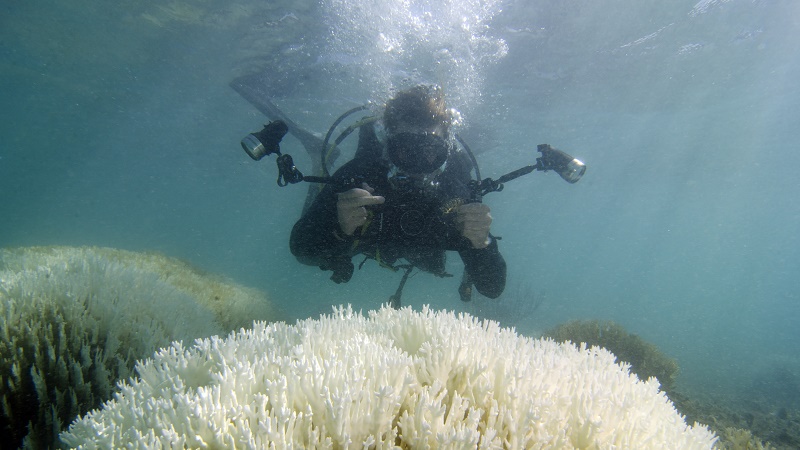Corals affected by mass bleaching on the northern Great Barrier Reef are “the sickest” Australian scientists have ever seen.
The corals have been hit by unusually high sea temperatures – a consequence of El Niño, the periodic blister of heat that bubbles up in the Pacific and started in full force last year.
Corals thrive in tropic seas, but, like all animals, there is a limit to their heat tolerance. And in a year in which global temperatures each month have set records, even the corals are feeling the heat, scientists told this week’s 13th International Coral Reef Symposium in Honolulu, Hawaii.
Terry Hughes, director of the ARC Centre of Excellence for Coral Reef Studies (CoralCoE) at James Cook University in Queensland, said: “We measured the condition of surviving corals as part of our extensive underwater surveys of Australia’s worst-ever bleaching event. We found that coral bleaching has affected 93% of the Great Barrier Reef.
Weekly briefing: Sign up for your essential climate politics update
“While the central and southern regions have escaped with minor damage, nearly half of the corals have been killed by mass bleaching in the northern region.”
His CoralCoE colleague, Bill Leggat, head of the Symbiosis Genomics Research Group, said: “Normally, when bleaching kills corals it is a slow death that progresses steadily when temperatures remain high. The corals usually rely on mechanisms that help them fight and counteract the damage. But this time, on some reefs, it looks like they have died very quickly.”
Coral and algae called zooxanthellae live in a mutual help relationship. The algae harness the light to make nutrients that nourish the coral host, and they also give the corals the pattern of colours that make the reefs such a marvel.
But as temperatures soar beyond the coral comfort zone, the relationship breaks down. Where a healthy coral polyp might have up to two million zooxanthellae per square centimetre, numbers may drop to 200,000 in a bleaching event.
But this time, at least in the northern end of the reef, conditions are much worse. Some corals have almost no algal partners left.
“These corals are among the most damaged I have seen,” Dr Leggat said. “For some surviving corals in the northern Great Barrier Reef, over 50% of the coral cells are dead. In some regions, the corals were so badly damaged that we were unable to study their tissue because it was rotting away.”
“It’s time to shift this conversation to what can be done to conserve these amazing organisms… local conservation buys us time, but it isn’t enough”
Bleaching and devastation were first reported last year. Coral is already threatened by insidious change in sea water chemistry as ever more carbonic acid – from dissolved atmospheric carbon dioxide, the product of the combustion of fossil fuels – gets into the sea.
Rising sea levels also present a problem. Researchers believe that the loss of the Bramble Cay melomys, a rodent native to the reef, could be counted as the first real mammal extinction laid directly at the door of climate change.
Reefs normally support rich and complex ecosystems, but when the reef suffers, so do all the creatures that make their homes in the corals.
Coral reefs have been hit by massive bleaching events in the past, and recovered. But this event seems more sustained. A report from the US National Oceanic and Atmospheric Administration (NOAA) suggests that many coral reefs will be exposed to higher-than-normal sea temperatures for the third year in a row, with damage to reefs in Hawaii, Guam, the northern Mariana islands, the Florida Keys, the US Virgin Islands and Puerto Rico.
“It’s time to shift this conversation to what can be done to conserve these amazing organisms in the face of this unprecedented global bleaching event,” says Jennifer Koss, coral reef conservation programme director at the NOAA.
“We have boots on the ground and fins in the water to reduce local stressors. Local conservation buys us time, but it isn’t enough. Globally, we need to better understand what actions we all can take to combat the effects of climate change.”
Combination punch
Even so, there is some hope. A study backed by 35 scientists reporting for the UN Environment Programme says that reefs nearest the surface along the full length of the Great Barrier have been affected by the combination punch of global warming and the extremes of El Niño.
But it says that deeper reef environments – 40 metres to 150 metres below the waves – could serve as a refuge for species driven from the shallows, although more research needs to be done to establish a role for these regions.
“They aren’t a silver bullet, but they may be able to resist the most immediate impacts of climate change – thereby providing a refuge for some species and potentially helping to replenish destroyed surface reef and fish populations,” says Professor Elaine Baker, a senior expert at of the University of Sydney’s school of geosciences.
This article was produced by Climate News Network
